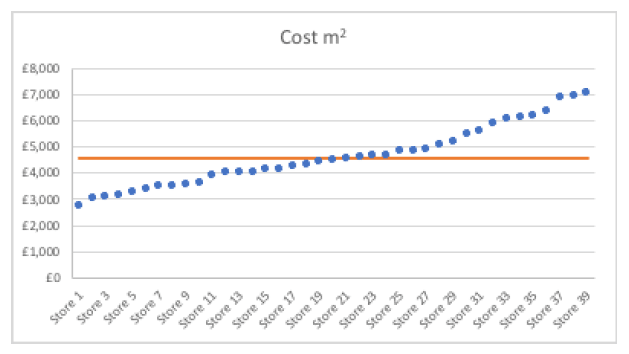Deposit return scheme: impact on small grocers
A report setting out a table of the values which have been derived and the approach that was taken to generating them.
Section 3: Methodology & Analysis
3.1 Data Collection
3.1.1 Multiple Group : Data Collected on location
A significant contributor to the sample was a Multiple Group which has 187 stores generally located throughout Scotland (with some also in the north of England).
The vast majority of its stores are less than 280m2 in size (although it does both smaller and larger ones - covering 99m2 to 1,200m2) and a number of these were selected for the analysis - these being the ones large enough to accommodate a DRS machine (or a manual return process).
It should be noted that each of the stores selected has a unique characteristic (either in its size, the way it is laid out, how it is operated or in its location - covering inner-city through to rural) and that there is no such thing as a 'standard' or 'typical' store.
The sample therefore provided a really good population for this study; the data collection being undertaken at the Head Office of the Multiple Group, attended by The Director of Retail, The Head of Commercial Finance, A Senior Accountant, and the Edinburgh Numberworks.
Over a 3.5-hour interactive meeting, data was extracted from a live database, discussed and analysed. The Management Team also made further comments which are included in Section 5.
3.1.2 Small Independents : Data Collected by telephone & email
The smaller, independent stores selected were contacted by phone and data was then requested by email.
3.1.3 A Final Sample of 40 stores makes up the Study Sample
It was agreed with the Scottish Grocers Federation that the sample of 40 was more than adequate for a useful study and would provide an excellent population to calculate the results from.
As noted previously, each of the 40 stores was different and provided an excellent range for the study. It was also noted that obtaining data from smaller stores is typically hard - either getting hold of the owner, getting their time to provide the information, or simply them knowing the information required in adequate detail.
3.2 Analysis of the Data
3.2.1 What constitutes Cost?
There are a number of costs likely to be incurred by a Store running a DRS scheme:
3.2.1.1 Loss of profitable floor space
This being the gross profit generated by stock items which would be lost to a DRS machine replacing them.
Certain income streams do not require floor space (which a DRS machine would take up) such as gaming/lottery cards placed at the counter or cigarettes (which are kept behind the counter); so the profit on these types of items was excluded.
The wider costs of running a store would need to be covered whether a DRS machine was in place or not, for example overheads such as rents, accountancy fees and window cleaning. Gross Profit was therefore used (rather than operating profit) since it excludes such non-relevant expenditure. Gross Profit is a more relevant figure as it is this profit which will be lost by installing a DRS machine. Non-relevant expenditure will continue whether a DRS machine is in place or not.
The study also took a year's worth of profit - as close to the study date as possible - to even out (for example) the highs of Christmas and the lows of January trading.
This is the cost which is included in the 'Table of Values' in Section 2.
3.2.1.2 Staff Costs
This second type of cost is addressed in Section 4 and included in the 'Table of Values' in Section 2.
3.2.1.3 Other Costs
Other costs are noted in Section 5 but are not included in the 'Table of Values' in Section 2, since these may (or may not) be a cost to the Store (the Scheme is yet to confirm the responsibility for each of these costs).
3.2.2 Which "square metres" have been included?
The study was only interested in the relevant sales area of the store. Areas that would not be affected were excluded, including for example: the store room, the till areas, staff kitchen and outside areas.
In other words, only the 'square metres' used in selling the items that were included in the profit (3.2.1.1 above) were included in the calculation.
3.2.3 Cost m2 - analysis of the Sample of 40 stores
The red line shows the average of the 40 stores, which is shown in Section 2 Table Of Values £4,541:

Contact
Email: eqce.cezw@gov.scot
There is a problem
Thanks for your feedback